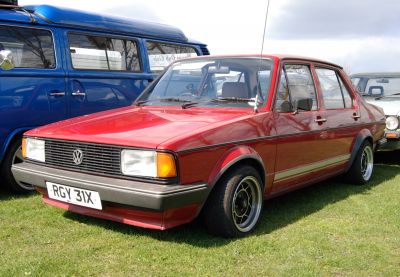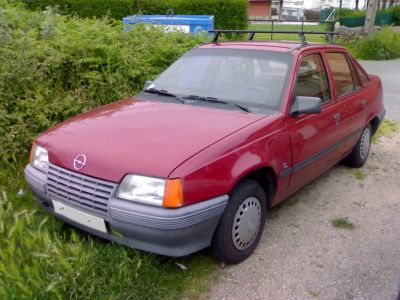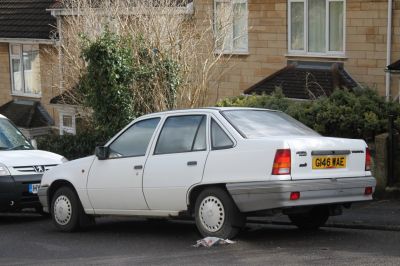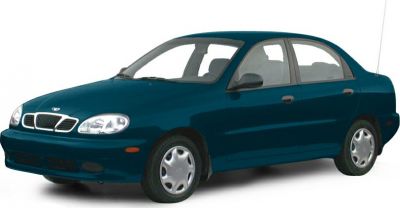 1997 Chevrolet Lanos Dimensions, Size & Specs
1997 Chevrolet Lanos Dimensions, Size & Specs
Measurements of the 1997 Chevrolet Lanos, engineered for optimal performance and comfort
| Dimensions | |
|---|---|
| Length: | 4237 mm166.8 in13.9 ft |
| Width: | 1678 mm66.1 in5.5 ft |
| Height: | 1432 mm56.4 in4.7 ft |
| Trunk Capacity: | 322 liter11.4 cu ft |
| Trunk Capacity (Max): | 958 liter33.8 cu ft |
| Tire Specifications | |
| Rims Size: | 14-inch rims:
|
| Tire Size: |
|
The Chevrolet Lanos, produced between 1997 and 2002, is a compact sedan designed to offer practicality and efficient use of space. Measuring 4237 mm (166.9 inches) in length, 1678 mm (66.1 inches) in width, and 1432 mm (56.3 inches) in height, the Lanos fits well within the compact car segment, providing comfortable urban mobility with a modest footprint.
This generation of the Lanos is tailored for drivers seeking an economical vehicle with sufficient interior space. One key highlight is its practical luggage compartment, which offers a capacity of 322 liters (11.4 cubic feet) under normal conditions. When the rear seats are folded down, the cargo volume expands significantly to 958 liters (33.8 cubic feet), enhancing its versatility for carrying larger items or extra luggage.
The vehicle rides on 14-inch rims specified as 5.5J x 14, complemented by tires sized 185/60 R14, balancing comfort and handling for everyday driving needs. These dimensions and components contribute to the Lanos' reputation as a reliable and easy-to-maneuver sedan.
Overall, the Chevrolet Lanos (1997-2002) generation offers a thoughtfully sized and versatile compact sedan option with balanced dimensions, making it suitable for city driving and small families. Its relatively spacious boot capacity and practical fold-flat rear seats add significant value to its daily usability.
Discover the standout features that make the 1997 Chevrolet Lanos a leader in its class
Have a question? Please check our knowledgebase first.
The Chevrolet Lanos sedan produced between 1997 and 2002 features a length of 4237 mm (approximately 166.8 inches), a width of 1678 mm (about 66.1 inches), and a height of 1432 mm (roughly 56.3 inches). These dimensions contribute to a compact yet practical vehicle size suitable for urban and suburban driving conditions. Its size gives it a balanced footprint that is manageable in tight spaces while still providing comfortable interior space for passengers.
The Chevrolet Lanos sedan from 1997 to 2002 offers a luggage capacity of 322 liters (approximately 11.4 cubic feet) with the rear seats in their upright position. When the rear seats are folded down, the luggage capacity significantly increases to 958 liters (around 33.8 cubic feet), making the car very practical for carrying larger or bulkier items. This flexibility in cargo space is a key feature for those needing to switch between passenger transport and cargo hauling.
The Chevrolet Lanos produced between 1997 and 2002 typically comes equipped with 5.5J x 14 rims paired with tires sized 185/60 R14. This tire and rim combination provides a balance between ride comfort, handling, and affordability. The 14-inch wheels are common in compact sedans, allowing for easy replacements and good availability of tire options.
Yes, the Chevrolet Lanos from the 1997 to 2002 generation fits easily into a standard garage. With an overall length of 4237 mm (166.8 inches), width of 1678 mm (66.1 inches), and height of 1432 mm (56.3 inches), it is well within the typical dimensions of standard residential garages. This makes it convenient for owners who need to park indoors, protecting the vehicle from weather elements while maximizing space efficiency.
The Chevrolet Lanos (1997–2002) was essentially the first generation of the model, so it does not have a predecessor model within the Chevrolet brand. The Lanos was introduced as a compact sedan aimed at affordable, practical transportation. Compared to other compact sedans of its time, it emphasized a balanced size with practical interior and cargo space, making it competitive in its class without an earlier generation for direct size comparison.
When compared to similar compact sedans from the late 1990s, such as the Hyundai Accent, Toyota Corolla, or Ford Escort, the Chevrolet Lanos holds its own in terms of size. With a length of 4237 mm (166.8 inches), it is slightly smaller or on par with competitors whose lengths typically ranged between 4200 mm (165.4 inches) and 4350 mm (171.3 inches). The width of 1678 mm (66.1 inches) and height of 1432 mm (56.3 inches) also align well with the segment norms, contributing to its competitive offering of interior space and ease of maneuverability.
While exact ground clearance and curb weight figures can vary by specific trim and market, the Chevrolet Lanos from 1997 to 2002 generally has a moderate ground clearance typical for compact sedans, which ranges around 140-160 mm (5.5-6.3 inches), allowing for ease of driving on city streets and light rural roads. The curb weight usually lies between 1,000 to 1,100 kilograms (2,205 to 2,425 pounds), which supports fuel efficiency and nimble handling.
The interior of the 1997-2002 Chevrolet Lanos offers a comfortable cabin for a compact sedan, designed to accommodate four to five passengers with adequate headroom and legroom. The vehicle's width of 1678 mm (66.1 inches) helps provide sufficient shoulder room, while the height and length allow for reasonable seating comfort. Though not overly spacious like midsize sedans, the Lanos strikes a practical balance, making it suitable for daily commuting and family use.
The Chevrolet Lanos from 1997 to 2002 was designed as an economical compact sedan, equipped with efficient engine options typical for its era. Fuel efficiency varies by engine type and market, but drivers could generally expect fuel consumption figures in the range of approximately 6 to 8 liters per 100 kilometers (around 29 to 39 miles per gallon). This makes it a cost-effective choice for city and suburban driving conditions.
The Chevrolet Lanos (1997–2002) excels with a combination of practical size, flexible cargo capacity, and affordable maintenance, making it a compelling choice in the compact sedan segment. Its modest dimensions allow for easy urban maneuverability and garage parking, while the foldable rear seats increase cargo flexibility to suit various needs. Additionally, its robust build quality and straightforward mechanics ensure long-term reliability. When compared to similar vehicles, its balance of interior space and economical operation significantly benefits those seeking a budget-friendly, versatile compact sedan.
Discover similar sized cars.

| Production: | 1979-1983 |
|---|---|
| Model Year: | 1979 |
| Length: | 4190 mm165.0 in |
| Width: | 1610-1630 mm63.4-64.2 in |
| Height: | 1395-1410 mm54.9-55.5 in |

| Production: | 1984-1993 |
|---|---|
| Model Year: | 1984 |
| Length: | 4218 mm166.1 in |
| Width: | 1658 mm65.3 in |
| Height: | 1400 mm55.1 in |

| Production: | 1984-1991 |
|---|---|
| Model Year: | 1985 |
| Length: | 4218 mm166.1 in |
| Width: | 1658 mm65.3 in |
| Height: | 1400 mm55.1 in |

| Production: | 1990-2005 |
|---|---|
| Model Year: | 1990 |
| Length: | 4205 mm165.6 in |
| Width: | 1650 mm65.0 in |
| Height: | 1402 mm55.2 in |

| Production: | 1994-2005 |
|---|---|
| Model Year: | 1994 |
| Length: | 4205 mm165.6 in |
| Width: | 1650 mm65.0 in |
| Height: | 1402 mm55.2 in |

| Model Year: | 1997 |
|---|---|
| Length: | 4237 mm166.8 in |
| Width: | 1678 mm66.1 in |
| Height: | 1432 mm56.4 in |

| Production: | 1998-2002 |
|---|---|
| Model Year: | 1997 |
| Length: | 4237 mm166.8 in |
| Width: | 1678 mm66.1 in |
| Height: | 1432 mm56.4 in |

| Production: | 1998-2004 |
|---|---|
| Model Year: | 1998 |
| Length: | 4252 mm167.4 in |
| Width: | 1967 mm77.4 in |
| Height: | 1425 mm56.1 in |
